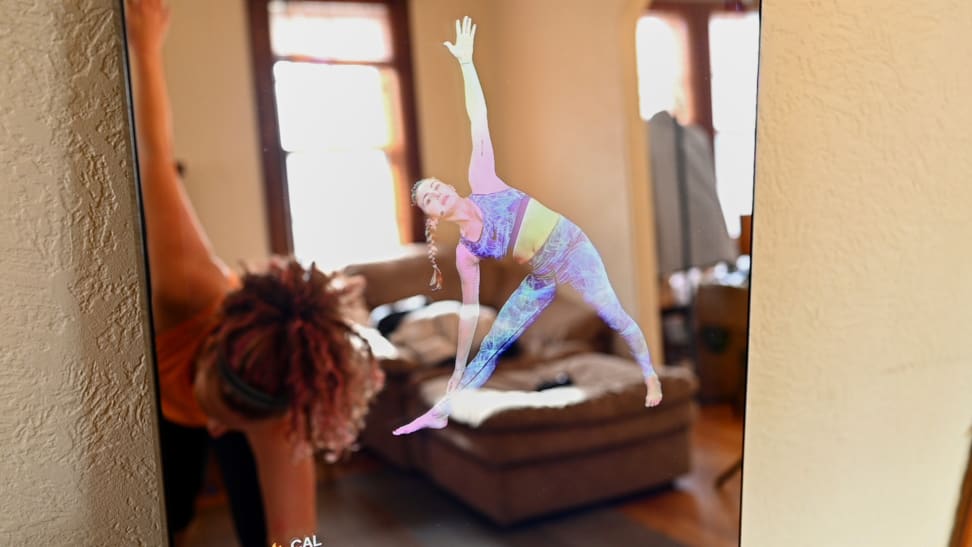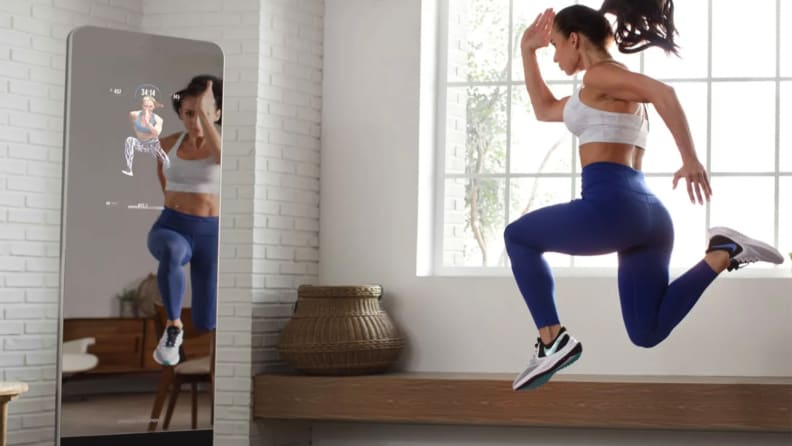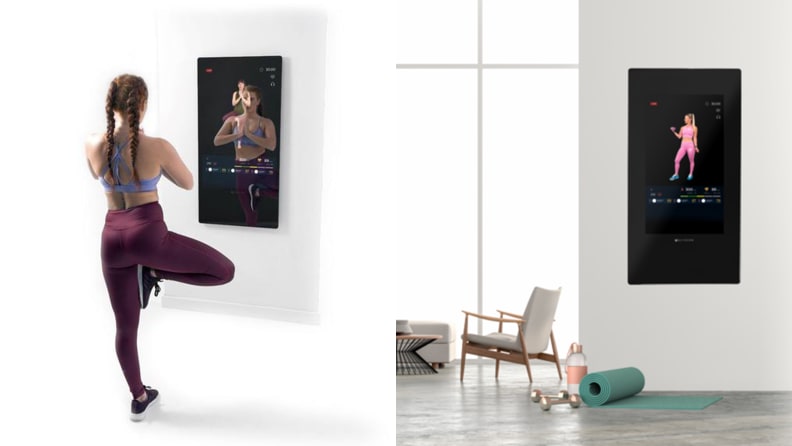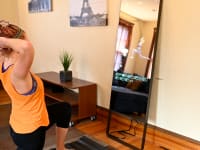A "smart" workout mirror could be the key to at-home exercise motivation
One thing's for sure: You'll get a good look at your routine.
 Credit:
Reviewed / Jackson Ruckar
Credit:
Reviewed / Jackson Ruckar
Products are chosen independently by our editors. Purchases made through our links may earn us a commission.
Over the past several years, a new phenomenon became inescapable in at-home fitness: mirrors. Well, not just any mirrors (those have been around for a while)—connected reflective fitness systems such as the Mirror that aim to bring the benefits of group and personalized fitness into the privacy of one's own home.
But these systems—which take a page from Peloton's playbook—are pricey. Each one can set you back $1,000 or (much) more, from the $999 Echelon Reflect to $4,495 Forme Life Studio Lift, plus the monthly membership fees to stay connected that average about $40 a month.
At that cost, you’ll want to make sure it’s worth the investment—and won’t just become an overpriced reflective surface in your home. We spoke with Chris Gagliardi, scientific education content manager at the American Council on Exercise, about how to find out if a smart connected mirror is right for you and how to make the most of it if you get one.
What exactly is a smart connected mirror system?

These systems allow you to watch yourself as you watch a workout video.
Popular reflective workout surfaces include Mirror, Echelon Reflect, Proform Vue, NordicTrack Vault, and Forme Life Studio. Tempo and Tonal are similar, but aren’t quite as reflective. (Here at Reviewed, we’ve tested the Mirror and Tonal and are fans of both.)
At first glance, most look like, well, a wall mirror. But with the flip of a switch or tap on the screen, the mirrored device comes to life as a video display, streaming live trainers or pre-recorded classes from beneath its reflective surface. At the same time, you can see your reflection atop the screen, so you can check if your moves match with the trainer's. In theory, this elevates the experience of doing an at-home workout video, especially if you can get live feedback from the trainer on the other side of the stream, which some system permit.
Class offerings vary between brands, but most include a wide swath of fitness options including HIIT, cardio dance, yoga, and strength training, that range from as little as five minutes in length to over an hour.
The physical size of the devices varies between models as well. Echelon’s Reflect 40 has the smallest footprint at 39 inches tall and 20 inches wide and weighs 39 pounds. The Forme Life Studio Lift is one of the largest at 72 inches tall, 26.3 inches wide, and a whopping 70 pounds. Because each of the systems functions a bit differently, so does the way they get set up in your home. Studio Lift requires wall mounting as does Tonal, which includes professional installation with its purchase. Tempo stands on its own storage system, while the rest can either be wall-mounted or used on a stand.
Many connected reflective fitness systems offer the added benefit of additional fitness equipment. The Vue and Tempo come standard with weight-training sets, while Tonal sports an impressive electromagnetic-resistance cable system, as does the Studio Lift, which includes everything from a mat to rope grips to a heart rate monitor. Some systems, like the Vault and Tempo, can store the equipment inside of them when not in use.
What are the benefits of working out in front of a connected mirror?
In general, it’s a good idea to work out in front of a mirror, whether it’s "smart" or not. “You’re going to get all the benefits of exercise no matter what you’re doing, but there is research that seeing yourself exercising can increase those benefits,” says Gagliardi. “You see yourself and think ‘I’m doing that, I did that.’ It’s a better motivator than just the desire to say, lose weight, because it’s literally capturing the essence of seeing yourself happy.”
Owning a connected mirror, then, may provide even more inspiration. These smart mirrors, with their ready-to-go workouts, can remove some barriers of getting to the gym, from lack of childcare to hectic schedules to, say, an unprecedented global pandemic that shuts down most out-of-home workout options. Being able to push a button and have a personal trainer appear in your living room is a perk that's much more likely to get people moving than if they have to sign up for a fitness class, pack a bag, and drive to the gym, says Gagliardi.
A connected mirror can also help with fitness technique. “Being able to compare what you are doing to what the trainer is doing helps people learn proper form and keep tempo,” Gagliardi says. Most of the systems have vast libraries of digital content and many ways for users of all training levels to access the fitness routines they're looking for. The option to engage with at least one other person (the trainer) and see them working hard—and having fun!—gives users a sense of being included. This is a key element in encouraging users to come back for more, and a necessity for long-term behavior change, according to Gagliardi.
Another potential bonus is how subtle connected mirrors are when installed in the home, at least compared to large pieces of fitness equipment like treadmills that often get hidden away in basements and garages due to their obtrusive size. A reflective fitness system can blend well into any decor, which provides a constant visual reminder to be active. “If you leave a dumbbell by your front door,” Gagliardi says, “you’re a lot more likely to pick it up and do something with it than if it was in your closet.” Likewise, with a smart mirror on the wall in your living room, there’s no hiding from your reflection and the goals you’ve set for yourself.
What are the downsides of reflective fitness systems?
First, there’s the price. Shelling out the equivalent of potentially a month of rent or a mortgage payment on a single piece of fitness equipment can be hard to justify, though many offer payment plans that make the cost more palatable (and akin to what you might pay on a gym membership). But beyond that, you’ll also want to consider some other factors.
Getting adequate strength training, for example, could prove to be an issue, depending on the system you get. Some options come with resistance equipment—the NordicTrack Vault and Tempo come with weights and Tonal has cables. But others don’t, which could mean you have to buy more equipment to take strength-training classes and find places to store the weights (which may defeat the whole aesthetic purpose of getting a mirror in the first place). “For some users that could be one of those barriers because it’s an extra step before getting to your workout,” says Gagliardi.
Not everyone feels comfortable seeing themselves working out, either. “You’re really forced to face exactly what you are looking at when you workout in front of a mirror,” Gagliardi says. “ It can bring out many different feelings when seeing your reflection. Some people might not be ready for that and it could potentially be a turn off.”
You may also end up needing more space than you think. The connected mirror itself can fit into a small space, but you need room in front of it to move around and set up a mat or those weights. Each company offers some guidance on the square footage required if you buy its connected mirror, and while most brands don’t have a specific space requirement, you won't get away with mounting it in a corner near furniture that's not easily moved.
Finally, though it may feel like you’re taking part in a boutique fitness class, you’re technically alone when you exercise with a smart mirror. Like all at-home workout methods, this removes the safety net of having people around, should you encounter an injury, health issue, or require a trained spotter for exercises that have you lifting heavy weights.
Can I get the same benefits while working out in front of a non-connected mirror?

These smart reflective surfaces offer some unique benefits.
If all that matters is a reflective surface, it's possible to bypass the connected mirror and use a tablet or smartphone in front of a regular mirror. You’ll still get the basic benefits of working out in front of a reflective surface—for instance, if you just want to check up on your form—but you may be more distracted than you think. “If I’m looking at two different things such as a mirror and a tablet, I might be blocking part of my view or not giving the mirror my full attention,” says Gagliardi. “With a connected reflective fitness system, you can imitate your own moves on top of the instructor in your mirror and see if your reflection mimics the instructor—something you can’t do with a regular mirror.”
At the core of it all, the goal of all connected reflective fitness systems is to provide connections—not only to trainers, but also to classmates. “These systems allow you to engage with your friends and family,” Gagliardi explains. “Most reflective fitness systems have the option to connect with multiple people and having that support and camaraderie is proven to help you stay on track.”
How can you make the most of a reflective fitness system?

If you get one of these systems, it's important to make the most of it.
So you’ve sprung for the likes of a Mirror, Vue, or Tempo. The next step is making sure you’ll reap all the benefits from it—and, like most fitness routines, you should start with the basics. “Starting with identifying your goals and evaluating what the current reality of what your life is like is the first step to success,” Gagliardi says. “What are the options for you to attain those goals and then what are you reasonably able and willing to do to attain them?”
In this case, the system itself is key, but it’s not the only thing necessary for a quality workout. Gagliardi suggests asking yourself basic logistical questions such as, “Do I have enough floor space in front of my mirror?” and considering things like,“Will my downstairs neighbors or family members be annoyed if I keep jumping on my floor, or do I need to lay foam down first?” You’ll also want to make sure you have the proper equipment necessary for your workouts, such as quality shoes, a yoga mat, or weights.
Once you’ve gotten familiar with the system, Gagliardi suggests branching out. “You’ve paid for it, so explore the content, find new classes, and use the options that are available to you, such as connecting your system to your fitness tracker so that you can more stats in real time,” says Gagliardi. He also suggests syncing the app with your smartphone or tablet, so that even when you are traveling, you can still access the content. This makes your fitness routine a lifestyle rather than a time block on your calendar.
“I can’t stress enough what a unique piece of equipment reflective fitness systems are,” Gagliardi says. “It’s a brand-new way to connect people and deliver fitness into a home setting. When you walk by and see your reflection staring back at you and you are happy with what you see or in some cases not happy with what you see, the system is right there.”
If that sounds appealing to you, and you can commit to using it, a connected mirror could be worth it.


